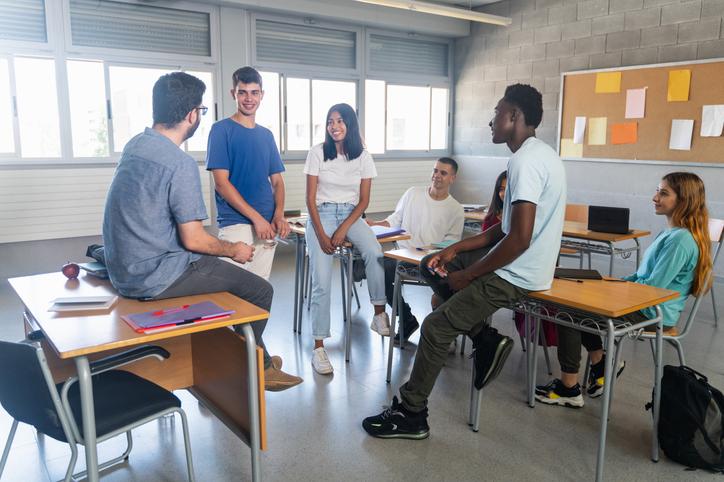
Using active learning to increase student engagement and understanding
There is not a great deal of contemporary literature on active learning in a large group setting that does not involve using blended or flipped learning. Lectures have traditionally employed a teacher-centred approach, facilitating the transmission of information from the instructor to the students. In my experience, this traditional approach tends to lead to a reduction in student attendance, as students do not see the benefit of their physical presence in class when they can simply watch the recording online. This approach also means there is an inability, as a lecturer, to know if your students are understanding the content delivered or whether they are just suffering through.
- Active learning strategies to boost student engagement
- Four ways active learning can transform learning experiences
- The active lecture: student-centred learning for the future
Redesigning a course to enhance student learning does not have to be complicated. I will outline simple, effective steps based on my experience with a first-year biosciences course that received overwhelmingly positive feedback from the cohort. Through employing an active learning strategy, within both lectures and workshops, you can have a positive impact on student attendance and engagement.
What are the observable barriers for students in your course?
It is important to first identify the barriers that your students might experience in your course if you are to make meaningful change. Is it the length of your classes? The current delivery mode? The perceived difficulty of the course content? For allied health students (physiotherapy, occupational therapy and speech pathology) at the University of Adelaide, it was all three.
Before you make changes to the delivery of your course, you need to understand the impact of the delivery on the student’s learning experience. Look at what past student experience surveys are telling you about the barriers students are up against, and reflect on how the design might be exacerbating these. We saw that students were overwhelmed by content-heavy topics such as anatomy and physiology. This was not helped by two-hour lectures and two-hour workshops each week in an intensive course. The student learning experience must be your driver for change.
What active learning strategies can you employ in your course?
Once you have identified potential barriers to student learning in your course, you can start to think about the active learning strategies that can help improve student attendance and engagement with the course and the learning material.
If you are working with lengthy class times, you might want to implement a strategy to break this up into smaller sections. This also helps students who are viewing or reviewing recorded lectures in the online learning management system (LMS). You might, for example, embed live interactions, which can come in the form of multiple-choice, short-answer and/or image-related questions – though note that all student answers should be completely anonymous. This can be done using a video recording and streaming platform directly within the LMS. You deliver and record the lecture through the system and the students simultaneously progress though the lecture on their chosen device. You will need to ensure that the interactions are placed strategically so that they appear directly after a block of content relating to a specific learning objective has been delivered.
Active learning can come in many shapes and sizes, and you don’t have to be technologically savvy to make them part of your common practice. Here are some further ideas to get you started:
− Break up your classes with role play
− Host mini, game show-style quizzes
− Pass around a learning resource for the students to touch and feel. What that is will depend on your discipline – we use preserved anatomy specimens!
− Include a ball-throwing Q&A activity to get the students moving
− Ask students to draw a concept that you have just explained
− Have students briefly teach a concept to their neighbour
Not only are you providing your students with mental breaks, but you also reduce the chances of their becoming overwhelmed by new concepts, all while catering to many different learning approaches.
What are the benefits of active learning for you, the teacher?
Aside from the relief that comes from having a happy, engaged cohort, active learning also serves as a convenient tool to measure student comprehension in the moment and adapt content delivery as required.
If you embed live interactions in your lecture, the resulting student responses will allow you to immediately test the students’ understanding of the concept just delivered. If you see that students are selecting the correct answers, you can confidently move on to the next concept.
If you start to see a trend of incorrect answers, revisit the concept and try to explain it in a different way. Or you can apply a step-by-step, funnel approach. This means starting with a broader concept and narrowing down to the key concept while linking back.
Active learning can also sustain higher student attendance and engagement in classes.
Key learnings
There are simple yet effective ways to use active learning to increase student engagement and encourage continued student attendance in your classes. Before choosing your active learning strategy, it is important to first understand the barriers to student learning that may exist in your course. The strategy that you employ does not have to be high tech nor time consuming for you as a teacher; however, it can make a positive difference to the experience of your students.
Ingrid Sierp is a lecturer in the School of Allied Health and Science Practice at the University of Adelaide, Australia.
If you would like advice and insight from academics and university staff delivered direct to your inbox each week, sign up for the Campus newsletter.




